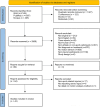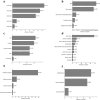Sensor-based technologies for motion analysis in sports injuries: a scoping review
- PMID: 39885587
- PMCID: PMC11780775
- DOI: 10.1186/s13102-025-01063-z
Sensor-based technologies for motion analysis in sports injuries: a scoping review
Abstract
Background: Insightful motion analysis provides valuable information for athlete health, a crucial aspect of sports medicine. This systematic review presents an analytical overview of the use of various sensors in motion analysis for sports injury assessment.
Methods: A comprehensive search of PubMed/MEDLINE, Scopus, and Web of Science was conducted in February 2024 using search terms related to "sport", "athlete", "sensor-based technology", "motion analysis", and "injury." Studies were included based on PCC (Participants, Concept, Context) criteria. Key data, including sensor types, motion data processing methods, injury and sport types, and application areas, were extracted and analyzed.
Results: Forty-two studies met the inclusion criteria. Inertial measurement unit (IMU) sensors were the most commonly used for motion data collection. Sensor fusion techniques have gained traction, particularly for rehabilitation assessment. Knee injuries and joint sprains were the most frequently studied injuries, with statistical methods being the predominant approach to data analysis.
Conclusions: This review comprehensively explains sensor-based techniques in sports injury motion analysis. Significant research gaps, including the integration of advanced processing techniques, real-world applicability, and the inclusion of underrepresented domains such as adaptive sports, highlight opportunities for innovation. Bridging these gaps can drive the development of more effective, accessible, and personalized solutions in sports health.
Keywords: Feedback; Injury; Motion analysis; Rehabilitation; Sensor; Sport.
© 2025. The Author(s).
Conflict of interest statement
Declarations. Ethics approval and consent to participate: This study was approved by the Ethics Committee of Mashhad University of Medical Sciences and Medical School (Ethical code: IR.MUMS.MEDICAL.REC.1403.145). Consent for publication: Not applicable. Competing interests: The authors declare no competing interests.
Figures



Similar articles
-
Review of Real-Time Biomechanical Feedback Systems in Sport and Rehabilitation.Sensors (Basel). 2022 Apr 14;22(8):3006. doi: 10.3390/s22083006. Sensors (Basel). 2022. PMID: 35458991 Free PMC article. Review.
-
The Fundamentals and Applications of Wearable Sensor Devices in Sports Medicine: A Scoping Review.Arthroscopy. 2025 Feb;41(2):473-492. doi: 10.1016/j.arthro.2024.01.042. Epub 2024 Feb 7. Arthroscopy. 2025. PMID: 38331364
-
Application of Sensor Technology in Wheelchair Sports for Real-Time Data Collection during Training and Competition and for Assessment of Performance Parameters: A Systematic Review and Future Directions.Sensors (Basel). 2024 Sep 30;24(19):6343. doi: 10.3390/s24196343. Sensors (Basel). 2024. PMID: 39409401 Free PMC article.
-
Inertial Measurement Unit Sensor-to-Segment Calibration Comparison for Sport-Specific Motion Analysis.Sensors (Basel). 2023 Sep 20;23(18):7987. doi: 10.3390/s23187987. Sensors (Basel). 2023. PMID: 37766040 Free PMC article.
-
Applications of wearable sensors in upper extremity MSK conditions: a scoping review.J Neuroeng Rehabil. 2023 Nov 18;20(1):158. doi: 10.1186/s12984-023-01274-w. J Neuroeng Rehabil. 2023. PMID: 37980497 Free PMC article.
References
-
- Knudson D. Introduction to biomechanics of human movement. In: Fundamentals of biomechanics. Boston: Springer; 2007. p. 3–22.
-
- Jha R, Mishara P, Kumar S. Advancements in optical fiber-based wearable sensors for smart health monitoring. Biosens Bioelectron. 2024;15:254. - PubMed
-
- Cust EE, Sweeting AJ, Ball K, Robertson S. Machine and deep learning for sport-specific movement recognition: a systematic review of model development and performance. J Sports Sci. 2019;37(5):568–600. - PubMed
Grants and funding
LinkOut - more resources
Full Text Sources
Miscellaneous

